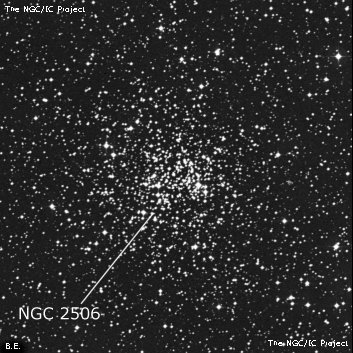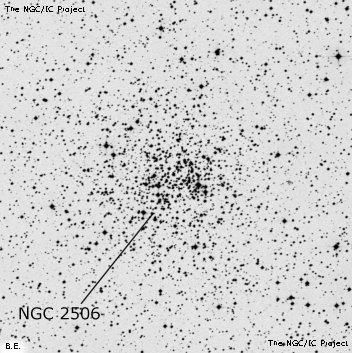NGC/IC Project Restoration Effort
(This is a very very beta version)
NGC2506


Basic Information
Location and Magnitude
Right Ascension: 8:0:1.7
Declination: -10:46:11
Constellation: MON
Visual Magnitude: 7.6
Historic Information
Discoverer: Herschel W.
Year of discovery: 1791
Discovery aperture: 18.7
Observational
Summary description: Cl, pL, vRi, C, st 11…20
Sub-type: I2r
Corwin's Notes
=====
NGC 2506. There was a bit of controversy about the declination of this
cluster. Dreyer reports it in a note in the NGC itself copied from the GC,
where JH acquiesces to two observations placing the cluster about 10 arcmin
south of his position. Dreyer followed up with another note in the second
IC with Howe's observation (reported in MN 58, 515, 1898) placing the cluster
at JH's NPD. This turns out to be right.
Curiously, CH's reduction in her fair copy of WH's sweep uses a different
star in the sweep ("199 Mon" in Bode's catalogue which is HD 69997) puts the
cluster at its correct position. My question has to be, "Did JH see his
aunt's reduction after she had Bode's star catalogue in hand?" That
reduction, of course, puts the cluster very close to JH's position. Had he
seen that, he would not have had any compunction at dismissing Harding's
incorrect position. But he must have only seen WH's published offsets from
26 Hydrae; those put the position about 7-8 arcmin north where the GC and NGC
have it, and where Howe did not find it.
So, JH was right all along, and WH was once again misled by some observing
error that his sister later caught.
In any event, the cluster is a relatively large and very rich one that would
be a treat to observe in any good-sized telescope.
Steve's Notes
=====
NGC 2506
18" (3/15/10): at 175x, this is a beautifully rich 8' group of stars, roughly circular, with 80-100 stars mag 11-14 over unresolved background haze. The brightest two stars are at the west side and form a wide, 27" double. The richest portion roughly forms a "U" outline, open to the south, as if a chunk of the cluster was missing. The north side of the "U" consists of a string of stars oriented WNW-ESE (north of the two brightest stars) with a pair at the WNW end. At the ESE end of this string a few brighter stars form a right angle heading SSW and forming another side of the "U". A faint string of stars extends out of the cluster to the SE and another string extends out the WNW.
17.5" (3/12/94): 75 stars in 10' diameter at 220x. The brightest members are a wide pair of mag 11/12 stars at the west end with a separation of 27" oriented SW-NE and a mag 11.5 star at the east end. Rich in mag 13-14 stars with a roughly circular outline except for a "bite" on the south side. The richest subgroup is following the two brighter stars at the west end and is 3' diameter forming a "C" shaped asterism opening to the south over haze and is quite striking.
13" (2/23/85): at 220x, ~35 stars visible, many in a winding row. A number of brighter mag 11 stars surround the group.



